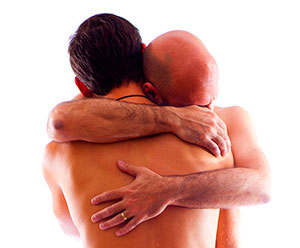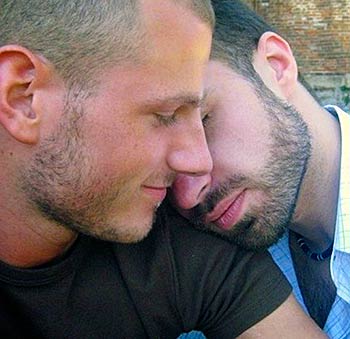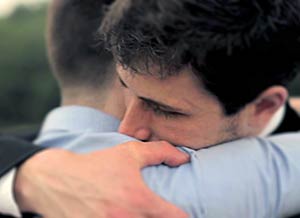SACRED INTIMACY, COMPASSION PRACTICE ::
KEVIN SMITH IS YOUR ’SNUGGLEBUD’
by Kilian Melloy
An article that originally appeared in EDGEBoston
Reprinted by permission
 Kevin Smith maintains a touch practice that’s a little different from that of most bodyworkers. Instead of basing his work on massage, assisted stretching, movement training, or other forms of touch, Smith practices a form of structured holding–a method he developed on his own over time, and which he calls “snuggling.” Indeed, Smith’s online ads offer his services under the rubric of “Snugglebud.”
Kevin Smith maintains a touch practice that’s a little different from that of most bodyworkers. Instead of basing his work on massage, assisted stretching, movement training, or other forms of touch, Smith practices a form of structured holding–a method he developed on his own over time, and which he calls “snuggling.” Indeed, Smith’s online ads offer his services under the rubric of “Snugglebud.”
Kevin Smith is not his real name. It’s a name he has assumed for the purposes of his touch practice, which he knows could all too easily be misconstrued and distorted. The touch sessions Smith offers are not sexual, and are not intended to provoke an erotic response. On the other hand, though Smith maintains strict boundaries around the level, quality, and type of touch that take place in a typical session, he doesn’t focus on erotic energy by demanding that it be absent from a session. There is a fine distinction between sexual touch and erotic contact, Smith notes, but the distinction is definite–and while Smith avoids sexualizing his sessions, he allows erotic energy to ebb and flow naturally.
“It’s like a cat,” Smith says of erotic charge. “It comes in and out; if you call it, it ignores you. If you tell it to leave, it’s all over you.” Allowing erotic energy to come and go without sexualizing the session allows that charge to build— and then dissipate— of its own accord. The result is a deeply relaxing process that relies on, and creates, trust.
In my own sessions with Smith, I’ve noticed less erotic energy than anxiety: another common reaction. Meeting me where I am— rather than where I think I am, or where I think I ought to be— Smith accepts my anxiety in a non-judgmental way, and then begins to work with it. A large part of the session consists of focusing on breath: “Let your breathing become slow and low,” Smith instructs gently. “Let your breath get deeper and fuller.”

 These instructions are murmured as we sit on cushions, facing one another. We are fully clothed. Smith has taken me into his arms. He might rub my back slowly, or rest his hand at a taut muscle; “Feel free to shift the container any way you need to” is a frequent invitation. By “container,” Smith means my body, my state of mind, the session itself— or a combination of all of those things. “Let your head rest wherever it’s comfortable,” Smith adds.
These instructions are murmured as we sit on cushions, facing one another. We are fully clothed. Smith has taken me into his arms. He might rub my back slowly, or rest his hand at a taut muscle; “Feel free to shift the container any way you need to” is a frequent invitation. By “container,” Smith means my body, my state of mind, the session itself— or a combination of all of those things. “Let your head rest wherever it’s comfortable,” Smith adds.
The simple act of focusing on my breath changes everything: the hour we have scheduled for the session becomes a large, inviting moment in time, not simply one more item on the day’s checklist. Worries about work and personal matters fade into the background. I become aware of an enormous amount of stress in my spine and shoulders, and by breathing deeper and more slowly I’m able to step back from that stress and allow it to dissipate. I also become conscious of the dread and anxiety I’ve been carrying around with me: Smith’s touch, and his guidance, direct me to my own mental and physical center, where I am able to take charge of my own physical and emotional state of being.
Smith invites me to lie down, into a modified yoga pose he calls “inverted partnered shavasana,” in which I am resting my weight partly on my own limbs and partly on him. He reminds me again about my breath, just as my thoughts start to pull me back out of the moment and into the anxieties that have co-opted my energy over the last few days. Suddenly, I’m no longer worrying: I’m relaxing, letting go of troubled thoughts. I even slip into a doze, and have a brief dream that I forget as I awaken a few moments later— but I’m waking up into a feeling of respite and mental clarity, rather than my accustomed laundry list of woes and difficulties. My thoughts have stopped racing. I feel calmer, and I feel safe.
“Hugging, Holding, Supportive Touch”
Smith advertises his practice on Craigslist, where he makes his methods and motives clear from the start.
“Hugging, Holding, Supportive Touch,” reads his ad. “NOT FOR SEX,” the text adds, parenthetically.
“I’m looking for guys interested in sharing a one-hour exchange with me in a style of mutual interactive touch which has become an evolving part of my own spiritual practice,” reads the ad. “It is not sex, and not a traditional massage where one person gives while another receives. Rather, it is a style of interactive, mutual touch that uses hugging, holding, light strokes, and evolves like an improvisation or a slow dance of touching each other.”
Smith is quick to disabuse anyone looking for sexual services that he provides the kind of touch they want. “I promise to respect any limits you may have (any places or ways in which you don’t want to be touched,” his ad reads. “My limits are: I do not want any kind of sex (oral, anal, masturbation) or anything ending in ejaculation.”
“There’s a tremendous amount of fear and suspicion around that sort of practice, because people think that it will lead to sex, or it must lead to sex,” Smith tells me. “But it’s possible, actually, to hold someone and have it not be sexual at all.”

 Smith describes his work not as a form of alternative medicine, but as an example of what he calls “compassion practice.” “I hug people, hold them, snuggle them, and cuddle them, as a form of empowerment,” Smith explains. “It’s actually a physical form of a Buddhist concept called compassion practice, in which we try to take in the suffering of other people and extend to them positive energy from our own selves.
Smith describes his work not as a form of alternative medicine, but as an example of what he calls “compassion practice.” “I hug people, hold them, snuggle them, and cuddle them, as a form of empowerment,” Smith explains. “It’s actually a physical form of a Buddhist concept called compassion practice, in which we try to take in the suffering of other people and extend to them positive energy from our own selves.
“There’s something about suffering where if you sit with it together, it’s not quite as bad,” Smith continues. “If you have someone who sits there with you in it— they don’t purport to fix it or remove it— it’s nice to have company when we’re tender and wounded. And [the suffering] does pass.
Though the work Smith describes sounds healing, Smith does not purport to be a healer. “I have no formal training,” he tells me. “I am not licensed, I do not do this for a profession. I do not charge, and have never accepted money for this practice. I am not a therapist.
“What I offer men is a skilled, caring partner,” Smith explains. “This work is a form of partnership; we do it together. That’s why I call it ’touch practice. ’ In fact, the man I am holding is doing more work than I am; I’m simply helping structure the time, form the right containers, monitor his breathing and provide support.”
A Virtue That Is Its Own Reward
“People have very often asked me, ’Why do you not charge money for this? This is worth paying for, ’ ” Smith recounts. “And my response is that I get a tremendous amount of satisfaction out of the work itself.
Any bodyworker knows it is impossible to touch without being touched in return; any philanthropist knows it is impossible to give a gift without getting tremendous satisfaction in return.
“If this work is helpful to people, if it helps people move forward in their bodies in the way that it helped me move forward in mine, if it provides some comfort and compassion and makes the world a better place for even one person, I have my payment,” Smith continues. “And besides, not charging money allows me to move simple and freely, in an unfettered way, giving this to the people who are interested in receiving it as I am freely able to, without obligation and without compromise.”
Smith’s touch practice fulfills different needs for the different individuals who come to him. Older straight men come to him for safe and supportive touch of a sort they may have assumed should be denied them because they were men, and not gay. Younger men engage in Smith’s snuggling sessions with fewer such reservations, but with more immediate results: they often open up, becoming more comfortable and assured in their own skins, after just a few sessions. Men of any sexual persuasion who suffer from compulsive sexual behavior find the physical intimacy they crave in a setting that allows them to accept touch without turning it into a fleeting sexual encounter.
“They are desperate to be touched, but they don’t want to have as much sex as they are having,” Smith says of the sexually compulsive clients with whom he works. “They are having sex in an effort to get closer to people and to get touch, but in the end it’s not satisfying, because in a lot of compulsory sexual behavior there isn’t a lot of touch–it’s kind of quick. One thing that can be helpful is to help people stay with the experience so that it doesn’t become sexual without their involvement, which is what happens in compulsory sexual behavior: people are having experiences that they are not really in. People have described this to me,” Smith adds, “they aren’t in their body while it’s happening, and they wake up ten minutes later, often with a sense of regret or of dissatisfaction.”
“This practice always begins fully clothed, and I have had many meaningful exchanges fully clothed,” Smith’s ad informs prospective snuggle partners. “I am also comfortable with partially-clothed or naked practice for those who are interested in the deeper engagement that provides. I am completely comfortable exploring the sensual and the erotic, as long as it remains within the both person’s limits.

 “If the focus is kept on sacred connection to each other, rather than merely ’getting off, ’ the experience of being touched intimately can be very moving,” Smith’s ad continues. “There is a difference for me between being gently and respectfully touched on private parts, versus a hand job. I’m not interested in the hand job.”
“If the focus is kept on sacred connection to each other, rather than merely ’getting off, ’ the experience of being touched intimately can be very moving,” Smith’s ad continues. “There is a difference for me between being gently and respectfully touched on private parts, versus a hand job. I’m not interested in the hand job.”
It’s true to say that Smith’s sessions are mentally and emotionally refreshing, but there is also a physical aspect to his work, which he readily acknowledges. The experience of supportive touch can be therapeutic for people who have experienced body-related traumas (such as childhood abuse, surgery or illness, or accidents, to name a few) and need to “re-enter” their bodies and learn how to stay engaged even when the course of their daily lives brings them to moments when they otherwise might reflexively “check out” of their bodies or go emotionally numb. Once more, it all begins–and comes back to–the breath.
“Breathing is really key,” Smith explains. “If a person is aware of their breathing, they are aware of their experience. If they are not aware of their breathing, they are having an experience that they’re not aware of. I can feel that in people as I am holding them; if I move my hand to their belly or their thigh, for example, they might stop breathing, because that experience is challenging to them. They check out of the experience. What I help them to do is stay with that experience, so that we can figure out what they want and need. Maybe they want to say, ’Take your hand off my thigh! ’
“A big part of the practice is finding out what your boundaries are, and learning to assert your boundaries so you can ask to have them respected,” Smith adds. “If you are aware of your experience, you can increase your capacity to carry it, to stay with it..”
Physical Insult, Spiritual Practice
“Some of the people who are attracted to this work with me are coming because of some physical insult to the body— sexual or physical abuse, an auto accident, major surgery— and they intuitively sense that being touched could be healing for them,” Smith tells me after our session, over cups of tea. “I believe this work can be of tremendous support for people working through abuse issues, and here’s why: abuse survivors often start by working on issues mentally–engaging in ’talk therapy’ or support groups where people talk and share emotions and memories, journaling, reading books, and so forth.
“While talking/thinking work is essential, it is often not the end of the road, because these are therapeutic modalities based in the mind, the emotions, the memory, whereas the actual insult took place in the body,” Smith continues. “There can be tremendous power in using touch to heal an area that was, in fact, wounded by touch in the first place.
“Of course, with someone with this kind of injury, touch needs to be engaged very carefully, very slowly, with tremendous awareness of experience and with the appropriate grounding mechanisms in place to support the emergence of experience which might be challenging or even painful,” Smith continues. “But I have seen people use this kind of work to move themselves forward in their bodies (not just their minds) in the process of recovery.”
It’s tough for anybody to be sexually healthy in a society like ours, in which sexuality is so deeply distrusted even as sex is used to market commercial goods to us all day, every day. A person need not have been sexually or physically abused to feel almost driven out of his or her body by the messages— mercenary and moral alike— with which we are barraged. Smith’s touch practice can bring mind and body— spirit and body! back together, and sexuality is a natural part of the equation.
“My experience in this practice is that our concept of sexual orientation is mostly a myth,” Smith tells me. “All men have the capacity, I think, for a full range of feelings. Some feelings may feel more natural to us, but it is also possible to practice a certain openness to all of our feelings. I believe that there’s a spectrum of possibility and feeling that we live in— and it’s fluid. You don’t have to declare a team at age 22 and then live your whole life in that one little box.
“As I have practiced my touch practice, my erotic feelings of women have increased and made themselves powerfully known,” Smith clarifies. “I have identified most of my life as a gay man, but although I am partnered to another men, I no longer identify as a gay man–I have sexual feelings for everybody.”
Compassion Practice

 But sexual gratification is not the essence or the motive for his touch practice, Smith reminds me, steering the conversation back to his “compassion practice.” Smith explains this further, saying, “Compassion towards others starts with compassion for ourselves; finding a way to take care of our own deep inner needs often equips us with insight that allows us to attend to the needs of others.”
But sexual gratification is not the essence or the motive for his touch practice, Smith reminds me, steering the conversation back to his “compassion practice.” Smith explains this further, saying, “Compassion towards others starts with compassion for ourselves; finding a way to take care of our own deep inner needs often equips us with insight that allows us to attend to the needs of others.”
It was from a seed of personal need that Smith touch practice originated. “I began this practice for myself,” Smith discloses. “I had an insatiable, inexplicable need to be held, and held by a variety of people, and I started taking out Craigslist ads to see if I could find guys who were just interested in hugging. One of the earliest problems was that many of the people interested in holding me were also interested in giving me a blow job, and so I had to learn how to negotiate and establish boundaries so that I could get what I wanted, without getting what I didn’t want. And over time, I developed a technique for doing that, and the technique turned into a ritual, a practice.
“About the same time as things crystallized into ritual form, my practice partners began to say to me, ’Wow, you know, this is great, whatever this is. What do you call this? You should write a book about this. This was really good for me.” And, ironically, just about the time that I started to feel like my need to be held was satisfied, I noticed that I was doing good for others, having done good for myself. I became interested in sharing my practice with others and teaching about it. This past year I taught a class on it to about 16 men at a retreat center in New York, and it was very well received.
“So what started in some sense as a ’selfish’ project has turned into a gift that I can give to others looking for whatever it is that I set out to find,” adds Smith. “That’s how it is with compassion. Start out being a little kinder to yourself, and all of a sudden you’re able to do really kind things for the people around you.”
Smith’s Craigslist ad also delves into the underlying traditions that inform his touch practice, noting that snuggling is “a variation of an ancient tribal healing practice called ’cradling. ’ It emerged from my practice in yoga and a deep sense of connection to others.” In a description of his touch practice that he posted online, Smith notes that, “the goal of this practice is a caring interaction between two people, so every time I practice it, it is a completely different practice built for that specific person.
“I will ask my partner very specifically when we begin: ’Are there any areas where you do not want to be touched? ’ You can make that list as large or small as you like and I will respect those boundaries as sacred.
“It’s true that people don’t always know where their boundaries are,” Smith adds. “Sometimes a person will come and say, ’I’d like to do clothing-off practice, ’ and I can sense in the first moment of holding them that they are nowhere near ready to do that— they would check out very quickly. I often don’t take people as far or as fast as they think they would like to go, because I sense that they may not be ready. I’d say that many people who want to do this work are working through some kind of wounding.
“Many others are at the other end of the spectrum,” adds Smith. “They are celebratory and joyous, they love being in their bodies, and they’re like kids in a candy store sampling everything. Then there’s everybody in between.”
I ask whether there’s any discernible trend in the needs of Smith’s clientele. Are most of them sexual trauma survivors? Are most of them simply people who have been deprived of healthy, sustaining touch?

 The answer: people come for all those reasons. “There are also people who are attracted to this situationally,” Smith tells me. “I worked with a man who had just gotten through the long, painful death, by cancer, of his longtime partner. He was really raw and wounded, and he just wanted to be held. He missed his partner, and he thought this would be a good thing to do for himself. And it was good; he wrote me an email a year after the fact. He told me that it had gotten him through the year.”
The answer: people come for all those reasons. “There are also people who are attracted to this situationally,” Smith tells me. “I worked with a man who had just gotten through the long, painful death, by cancer, of his longtime partner. He was really raw and wounded, and he just wanted to be held. He missed his partner, and he thought this would be a good thing to do for himself. And it was good; he wrote me an email a year after the fact. He told me that it had gotten him through the year.”
Smith has something of a national client base, since he travels frequently. As his journeys take him to different cities, he often will reconnect with repeat clients. I ask Smith whether, in the course of pursuing his avocation, he has trained any other practitioners in his particular form of touch.
“I’m not aware of anyone who is doing exactly what I do, in exactly the way I’m doing it,” Smith tells me. “I’m not aware of people who are willing to have erotic energy be in the room, but also have pretty strict boundaries about that energy so that we can explore other areas of our experience.”
That said, “There are men who have practiced with me who have then gone on to establish their own practice,” Smith says. “I have helped them with the ads they might write on Craigslist, or how they might construct safe environment for themselves, how to establish safety about meeting people on the Internet. I’ve actually taught a class for men on how to establish what I call holding a sacred practice, which means holding others as part of a personal sacred practice.”
But there’s no reason others might not follow where Smith has led. “I don’t charge money for this, and I don’t hold any copyright on it,” he says. “This is a practice I want to do for free, I want put it out there in the world, and I think it can make people’s lives better.”
Smith leaves me with one more observation about the work that he does: it entails a certain kind of close connection that can be intense, even if it is in some sense transient. His work brings people back into their own skins— but also brings him closer to them, if only for an hour. “It’s possible to fall in love with anybody in the world,” Smith tells me. “It’s a function of how wide open you leave yourself.”
Kilian Melloy reviews media, conducts interviews, and writes commentary for EDGEBoston, where he also serves as Assistant Arts Editor.
Copyright © 2003-2010 EDGE Publications, Inc. | Reprinted by Permission



